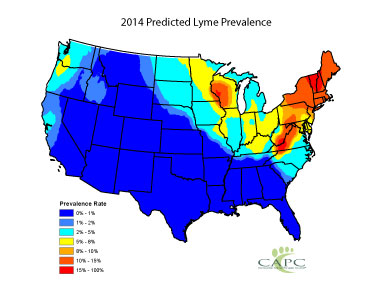Here is an interesting (and somewhat worrisome) article I found on the Companion Animal Parasite Council website. If you check the map, you can see that the St. Louis area is showing an increased incidence of Lyme Disease. If your dogs get ticks, make sure they're vaccinated! -DH
Lyme disease infection occurs when an infected tick feeds on a dog and transmits the organism that causes disease. The 2014 Parasite Forecast Maps from the Companion Animal Parasite Council show that Lyme disease is expanding westward from the historic focus of the northeastern United States. Southern New England and the Pacific Coast continue to be key hotspots of activity, and are likely to experience elevated rates of disease prevalence, with an increasing numbers of infections seen for this year. Consistently stable activity levels are predicted for the Mid-Atlantic States and the upper Midwest. The CAPC forecast also shows that Lyme continues to expand southward and involve more areas of Appalachia.
 Dogs infected with Lyme disease do not usually have the bull’s-eye-rash as seen in people, but may have clinical signs of fever, lameness, swollen joints, lethargy, and depression. Dogs cannot transmit Lyme disease to people, but they are considered a “sentinel” of the disease. This means a high prevalence of Lyme disease in dogs provides an advance human warning system of can provide a warning of humans contracting the disease.
Dogs infected with Lyme disease do not usually have the bull’s-eye-rash as seen in people, but may have clinical signs of fever, lameness, swollen joints, lethargy, and depression. Dogs cannot transmit Lyme disease to people, but they are considered a “sentinel” of the disease. This means a high prevalence of Lyme disease in dogs provides an advance human warning system of can provide a warning of humans contracting the disease.
The 2014 CAPC Parasite Forecast Maps have predicted higher-than-normal levels for Lyme disease in several areas of the country, which means dogs in these areas, may be at greater potential risk for infection. Even if you don’t live in an area where Lyme disease is a problem, there are many different tick-borne diseases, so year-round tick protection is still important. Dogs can also be exposed to tick-borne diseases if they travel with you to parts of the country where those diseases are more common.
CAPC bases its parasite forecasts on many different factors, including temperature, precipitation, humidity, ground elevation, forest cover, population density, reported human Lyme disease cases and deer strikes with cars. These factors are incorporated into an equation created by a team of statisticians that allows CAPC to predict the likelihood of any parasitic disease. The forecast is also the collective expert opinion of respected parasitologists who engage in ongoing research and data interpretation to better understand and monitor disease transmission and changing life cycles of parasites. Click here to learn more.
You can use the CAPC Parasite Prevalence Maps to check the risk for different parasitic diseases in your geographic area, down to the county level. You can also check the maps when you are traveling with your pet to other areas of the country so you can be aware of any possible new risks to protect you dogs against ticks. The maps provide statistics about the number of dogs infected by Lyme disease and other parasitic diseases by state and county. This information can serve as a helpful starting point for a discussion with your veterinarian about the best year-round parasite protection program for your pet.
Automatic email updates from CAPC will help you stay informed about ongoing parasite activity in your area. You can sign up by going to the CAPC Parasite Prevalence Maps and clicking on “Get Updates.” Enter your email address in the provided field and click “Subscribe.” You will begin receiving updates as soon as they are posted. Visit the How-To page to sign up now. Year-round parasite protection is essential for all pets, and knowing which diseases are more significant in your area will help keep your pets safe and free of parasites. Your veterinarian can help you decide how to best protect your pet against the threat of parasitic diseases.




